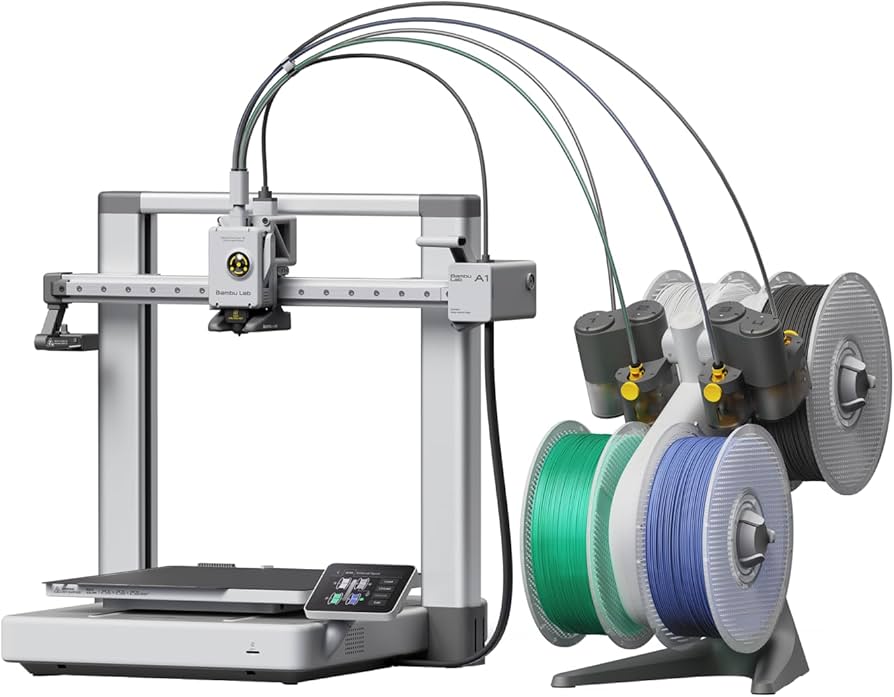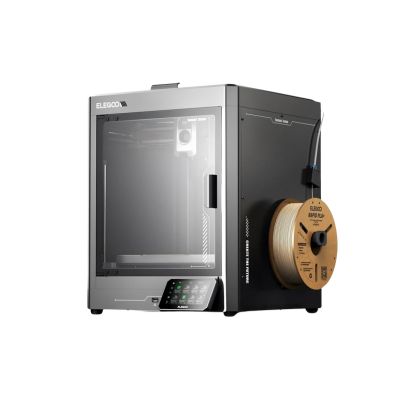Compare A1 vs Centauri Carbon
Comparison between the best 3D printers
Choose the best 3D printer at the best price. The cheapest 3D printers are here.
Buy a 3D printer here with 3D Fila.
 |
 |
|
| Model | A1[BUY A1] |
Centauri Carbon |
| Printing Material | Filament | Filament |
| Buy Filament for Bambu Lab A1 | Buy Filament forElegoo Centauri Carbon | |
| Estimated price | $700,00 | $500,00 |
| Manufacturer | Bambu Lab | Elegoo |
| Release Year | 2023 | 2025 |
| Print Volume [mm] | 256x256x256 | 256x256x256 |
| Printer Size [mm] | 385x410x430 | 500x500x600 |
| Weight [kg] | 8,3 | 17,5 |
| Power Loss Recovery | YES | YES |
| Enclosed printer | NO | YES |
| Bed Leveling | Automatic | Automatic |
| Filament End Sensor | YES | YES |
| Bed type | Heated | Heated |
| Power supply system | Direct Drive | Direct Drive |
| Standard nozzle | 0,4 | 0,4 |
| Maximum Nozzle Temperature [°C] | 300 | 300 |
| Maximum Bed Temperature [°C] | 100 | 110 |
| Maximum printing speed [mm/s] | 500 | 500 |
| Filament holder | YES | YES |
| Camera for supervision | YES | YES |
| Recommended filaments | PLA, PETG, TPU, PVA | PLA, PETG, ABS, ASA, TPU, NYLON, CARBON FIBER |
| Recommended slicers | SuperSlicer, PrusaSlicer, Cura, OrcaSlicer | Elegoo Slicer, Orca Slicer |
| Maximum Resolution [mm] | 0,1 | 0,1 |
| Processor | ||
| Display | Touchscreen 3,5 | Touchscreen 4,3'' |
| Power Supply | 350 W | 350 W |
| Connectivity | Wi-Fi, Bambu-Bus, Cartão Micro SD | WiFi, SD, USB |
| Operating systems | Windows, Linux, Macbook | Windows, Linux e Macbook |
| Date of registration in the system | 2024-07-17 | 2025-02-10 |
| Release date | 2023 | 2025 |
| Extra features | The BambuLab A1 printer features fully automatic calibration, multi-color printing with the AMS system, active flow rate compensation, quick nozzle change with a clip, active motor noise cancellation, a build volume of 256x256x256 mm³, a maximum extruder temperature of 300°C, and a heated bed of up to 100°C. In addition, it has high precision, a machine health management system and an intuitive 3.5-inch touchscreen interface. | The Elegoo Centauri Carbon is a CoreXY 3D printer with an enclosed structure, direct drive extruder, and hardened steel components for abrasive materials. It features automatic bed leveling, a touchscreen, a filament cutting system, and an elongated nozzle designed to reduce clogs. It offers Wi-Fi connectivity for remote file transfer and runs on a Klipper-based firmware, providing advanced control and precise adjustments. |
| Support for multiple colors and materials (AMS and CFS) | YES | NO |
Notes * |
||
| Cost-benefit | 7 / 10 | 8 / 10 |
| Hardware | 4.8 / 10 | 6 / 10 |
| Tela | . | . |
| Print volume | 4 / 10 | 4 / 10 |
| Performance | 4 / 10 | 4 / 10 |
| [BUY A1] |
Conclusion |
| In comparing the Bambu Lab A1 and the Elegoo Centauri Carbon 3D printers, several key factors emerge that will influence your purchasing decision. **Price and Cost-Benefit**: The Elegoo Centauri Carbon offers a better cost-benefit ratio, making it an attractive option for budget-conscious consumers. Despite its lower price point, it still provides robust features and a larger print volume, which can be particularly appealing for those seeking to maximize their investment. **Print Volume and Size**: The Centauri Carbon has a larger print volume, allowing for more extensive projects. This advantage may be pivotal for users intending to print larger parts or multiple smaller objects simultaneously. In contrast, while the Bambu Lab A1 is compact and lightweight, it has a smaller print capacity, which might limit its applicability for bigger projects. **Enclosure and Build Quality**: The Elegoo Centauri Carbon features an enclosed structure, which enhances temperature stability during printing and reduces the likelihood of warping with certain materials. This makes it particularly suited for advanced filaments like ABS and Nylon, whereas the A1's open design might be less favorable for these materials. **Features and Technology**: Both printers boast automatic bed leveling, power loss recovery, and touchscreen interfaces. However, the A1 includes additional features such as multi-color printing capabilities and advanced calibration techniques, making it a strong candidate for users focused on precision and versatility in various materials. **Materials Compatibility**: The Centauri Carbon supports a wider range of filaments, including more advanced materials like carbon fiber. This can broaden the possibilities for users looking to experiment with different projects. The A1, while versatile with common filaments, might not offer the same level of material flexibility. **Conclusion**: The decision between the Bambu Lab A1 and the Elegoo Centauri Carbon ultimately hinges on individual user needs. If budget constraints and a larger print volume are priorities, the Centauri Carbon stands out as a superior choice. Conversely, if cutting-edge features and precision are paramount, the A1 may be worth the investment. Each printer has its strengths and weaknesses, making it essential for potential buyers to evaluate their specific requirements and intended applications before making a purchase. |

